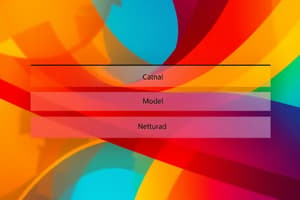Podcast
Questions and Answers
What does Media Access Control (MAC) sublayer regulate?
What does Media Access Control (MAC) sublayer regulate?
The placement of data frames onto the media.
What does the MAC method depend on?
What does the MAC method depend on?
- Topology
- Media sharing
- Both A and B (correct)
- None of the above
What does physical topology display?
What does physical topology display?
Physical connections and how end devices and infrastructure devices are interconnected.
What does logical topology display?
What does logical topology display?
Which of the following are WAN topologies?
Which of the following are WAN topologies?
What is a virtual circuit?
What is a virtual circuit?
In half duplex communication, devices can transmit and receive simultaneously.
In half duplex communication, devices can transmit and receive simultaneously.
In full duplex communication, devices can transmit and receive at the same time.
In full duplex communication, devices can transmit and receive at the same time.
What are the types of LAN topologies?
What are the types of LAN topologies?
Early star topologies interconnected end devices using ____.
Early star topologies interconnected end devices using ____.
In a bus topology, end systems are chained to each other and terminated in some form on each ____.
In a bus topology, end systems are chained to each other and terminated in some form on each ____.
In a ring topology, end systems are connected to their respective neighbor forming a ____.
In a ring topology, end systems are connected to their respective neighbor forming a ____.
What are the two kinds of media access control methods for shared media?
What are the two kinds of media access control methods for shared media?
What is Carrier Sense Multiple Access (CSMA)?
What is Carrier Sense Multiple Access (CSMA)?
What happens during Collision Detection (CSMA/CD)?
What happens during Collision Detection (CSMA/CD)?
What is Collision Avoidance (CSMA/CA)?
What is Collision Avoidance (CSMA/CA)?
What is the purpose of cyclic redundancy check (CRC)?
What is the purpose of cyclic redundancy check (CRC)?
What does Frame Check Sequence (FCS) help determine?
What does Frame Check Sequence (FCS) help determine?
What is Ethernet?
What is Ethernet?
What is the primary function of the Point-to-Point Protocol (PPP)?
What is the primary function of the Point-to-Point Protocol (PPP)?
What is 802.11 wireless known for?
What is 802.11 wireless known for?
Flashcards are hidden until you start studying
Study Notes
Media Access Control (MAC)
- Regulates data frame placement onto the communication medium.
Factors Influencing MAC Methods
- Depends on network topology.
- Media sharing characteristics such as point-to-point (WAN) and shared (LAN) networks.
Physical Topology
- Displays physical connections between end devices and infrastructure like routers and switches.
Logical Topology
- Shows network frame transfer from one node to another.
- Represents how the data link layer manages data access.
WAN Topologies
- Point-to-point: direct link between two endpoints.
- Hub-and-spoke: central site interlinks with branch sites using point-to-point connections.
- Full mesh: every endpoint is directly interconnected with each other.
Virtual Circuit
- Represents a logical connection within the network between two devices.
- Media access methods depend on logical, not physical, topologies.
Communication Types
- Half duplex: devices can send and receive, but not at the same time.
- Full duplex: devices can send and receive simultaneously.
LAN Topologies
- Star: end devices connect to a central device (switch).
- Extended star (hybrid): central device connects to various topologies.
- Bus: end systems chain together, terminated at both ends.
- Ring: end systems connected to neighbors forming a closed loop.
Media Access Control for Shared Media
- Two main access types: contention-based and control-based.
Contention-Based Access
- Nodes compete for media access, using collision handling strategies like listening before transmitting.
Control-Based Access
- Each node is assigned a time slot for media access, often using a token.
Carrier Sense Multiple Access (CSMA)
- Monitors the medium for signals before transmitting data.
Collision Detection (CSMA/CD)
- Devices check for data signals before transmission and back off if a collision is detected.
Collision Avoidance (CSMA/CA)
- Devices broadcast intent to use the medium before sending data, reducing the chance of collision.
Logical Multi-Access Topology
- Allows multiple nodes to communicate over shared media, ensuring only one node transmits at a time.
- All nodes receive all frames, but only the addressed node processes them.
Controlled Access Method
- Devices take turns accessing medium sequentially, with the opportunity passing if a device does not transmit.
Deterministic Access
- Utilizes a token to manage structured access to the medium.
Logical Ring Topology
- Each node processes incoming frames, passing unrouted frames to the next node.
Error Detection Mechanisms
- Cyclic Redundancy Check (CRC): summarizes frame contents for error detection.
- Frame Check Sequence (FCS): identifies errors in the transmission of frames.
Ethernet
- Dominant LAN technology utilizing CSMA/CD for unacknowledged connectionless service over shared media.
- Operates across two layers: IEEE 802.2 (LLC) and IEEE 802.3 (MAC).
Point-to-Point Protocol (PPP)
- Delivers frames between two nodes, developed as a WAN protocol for serial WANs.
- Establishes logical connections termed 'sessions' between nodes.
802.11 Wireless
- Utilizes electromagnetic signals in radio or microwave frequencies for data communication.
- Employs a contention-based system (CSMA/CA) with data link acknowledgments to confirm frame reception.
Studying That Suits You
Use AI to generate personalized quizzes and flashcards to suit your learning preferences.




